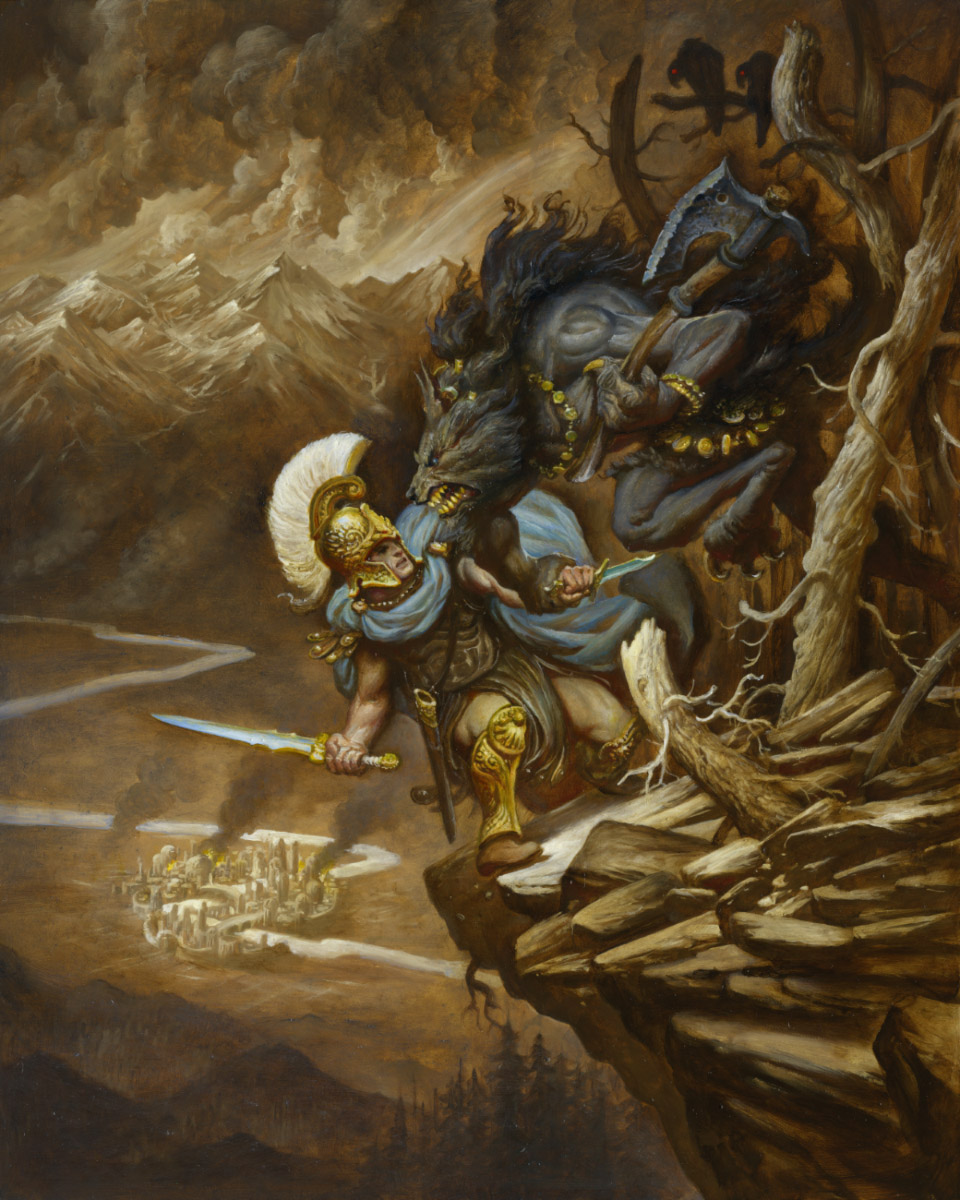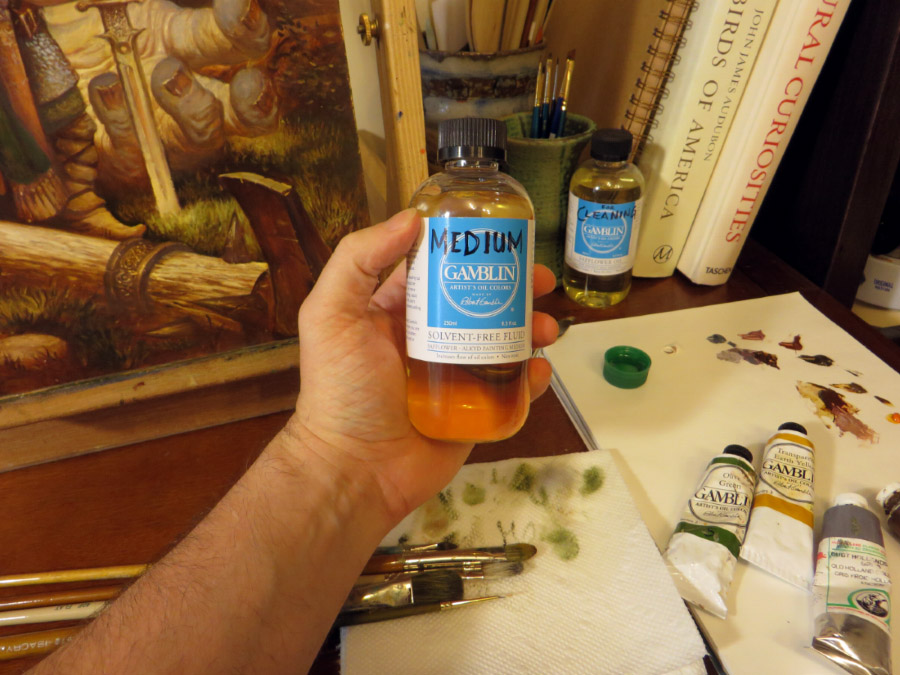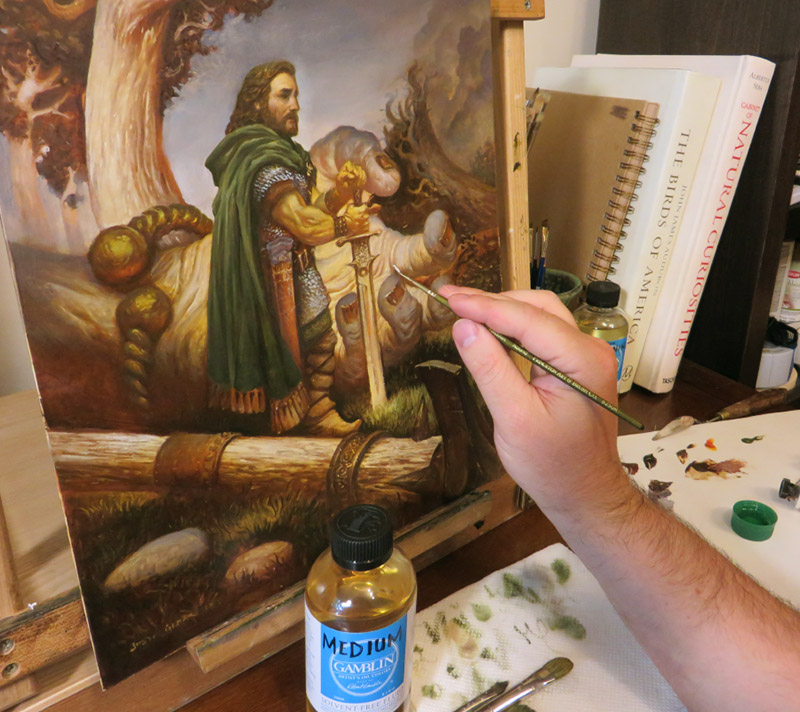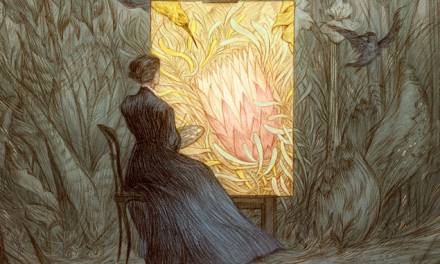1. Workability – That the paint itself allows for the smooth, buttery application consistent with that of traditional oil paints.
2. Archival-Longevity – That the final product will not suffer from any unreasonable, long-term degradation. (cracking, colors fading or darkening, wrinkling)
3. Fast-Drying – That if needed, a thin layer could be touch-dry, ready-to-paint-over, within 24 hours, but the medium itself stays workable for at least 8 hours.
4. Non-Toxic – That you can work solvent-free and in a non-toxic studio environment.
It was easy to find a medium that would offer three but seemed impossible to find a suitable one that would offer all four. Now finally, four years later I believe that I may have found a solution:
Enter: Gamblin’s Solvent-Free Fluid
The folks at Gamblin recently created this medium by adding an soy-based alkyd drying agent to Safflower oil. Safflower oil is wonderfully fluid and a pleasure to work with, but has the drawback of taking forever to dry. So for painters who are interested in painting indirectly using several layers, it can be problematic.
How is Gamblin’s Solvent-Free-Method more similar to solvents than other mediums?
Previously I had been using mediums based on either sun-thickened linseed oil or M. Graham’s Walnut Alkyd medium. Compared to these mediums, this medium is incredibly fluid and much more workable. It is much easier for me to get quick coverage of an area, and then simply not add any fluid if I want to slow down and paint an area with more control.
I found that if I need to carve out an area that I had already painted, (to sharpen the edges of a glaze for instance) that it allowed me to do this far more easily than other traditional mediums.
In general, I found that it allowed for a broader range of brushwork techniques than other mediums.
How is it different from working with actual solvents?
Compared to odorless mineral spirits it is still highly fluid, though not quite as fluid as OMS. I did however, find that it was close enough for my purposes.)
The main difference that I can see is that OMS evaporates as it dries, so your layer is extremely thin and there is very little build up. With Gamblin Solvent-Free Fluid you will have slightly more build-up since the medium does not evaporate and remains in the paint. Because of this Gamblin recommends never mixing more than 25% Solvent-Free Fluid with your paints.
Is the drying time noticeably better than traditional mediums?
Yes! I found that thin layers were dry in about 24 hours. While this was generally slower than OMS mixed with galkyd, liquin or a cobalt dryer, it was still much faster than other traditional mediums. I would compare it to the drying speed of M. Graham’s Walnut Alkyd Medium but with far more workability.
Is it easy to clean?
Yes. Gamblin recommended using Safflower oil for cleaning brushes so I decided to try that and was really pleased with the results. You definitely don’t need any turps or solvents to clean with this medium.
If you need to get your brushes clean for longer storage, a simple bathroom cleaning glove and a bar of soap and water will suffice to get your brushes perfectly clean.
A note on cleaning: The medium itself will stay open on your palette for several days. The tiny cap in the picture above stayed open and usable for several days, even while the thin layers on the canvas dried overnight. This amazed me since I had not sealed it in any way and planned on throwing it out the next day (which is what I would have been forced to do with other alkyd mediums).
This is good news as it means that even if you forget to clean your brushes the night before you will have no trouble getting them clean the next day.
A second note: Gamblin’s Safflower and their Solvent-Free Fluid look the same. This confusion led to studio mishaps, where Annie and I accidentally used the wrong one and couldn’t figure out why our paintings hadn’t dried in a week.
This is why the bottles now have hastily scrawled titles to keep them separate. Never again.
I’M LOOKING AT YOU GAMBLIN LABEL DEPARTMENT.
Would you recommend it?
Yes I would. It has been an absolute pleasure to work with so far and has gotten me excited about oil painting again.
My final verdict is if you do not have any trouble with turps and mineral spirits, you might find that OMS mixed with galkyd or liquin will work better for you. But if you are wanting to go non-toxic and solvent-free, then I would absolutely recommend this product.
I will add one last word of caution that this is a new medium which has not had time to be heavily tested for its long-term archival quality. As with any new medium, we can’t know exactly how it will look in 100 years. But the ingredients list seems clean and simple (which is always good for oil paint) and I feel like Gamblin is a trustworthy company which tests its products heavily and has a long history of providing excellent, archival painting materials.
If you have found an oil painting medium out there that you believe meets the 4 challenges above let me know in the comments and I will test it out!
Further Reading:
Link to Part I and Part II
Link to Dan Dos Santos Write-Up on Studio Safety: Solvents
Link to Gamblin’s Mediums section










Great post Justin! Just curious- what do you use for glazing? Or is glazing a big part of your technique?The Solvent Free Mediums have high fat content (hence the 25% ratio) and are not recommended for glazing as it will wrinkle. Do you then cut it with Gamsol?
I've found a lot more comfort using Gamsol these days- especially after talking at great length with the folks at Gamblin about it. I've discovered Neo Megilp is pretty wonderful to work with recently as well if I want a really smooth fluidity and a slightly longer drying time. (which can be adjusted by mixing other mediums). I hope we can talk shop a bit at Dragon Con this year. 🙂
Hey Kristina,
At this point it will be a drop of this solvent-free stuff for glazing. Glazing is definitely a big part of my technique (which is mostly just the old dutch-flemish method). I love painting sepia first and then adding color in stages. It's slower but just works better in my head.
I actually think this fluid stuff is great for glazing and it doesn't 'feel' too fatty, probably because I am using it very sparingly. But I have a tendency to use too much medium in the underpainting sometimes, (to carve out shapes and whatnot) and I do wonder if I am into problems staying thick over thin there.
Gamblin recommends cutting it with gamsol at that stage so we will see. I haven't tried thinning it yet but I am glad to hear that gamsol is back in for you! You'll have to tell me what you think about it at DragonCon!
How would you say this product is in terms of fumes? I live in a small apartment with not so good ventilation and have been trying to find a way I could oil paint. This stuff is non-toxic, but how smelly/vapory is it? What type of ventilation would you say is safe?
Hi Jennifer,
I haven't noticed any fumes (or even smell) at all so far. I believe this is because it is primarily made from safflower and soy, which emit no fumes. The MSDS from Gamblin's site seems to confirm this and I don't think there is anything inside the product that even can make fumes.
You won't have to worry about your ventilation if this is all you are using to paint with.
Thank you for such a fast reply! This is wonderful news then because sometimes I miss traditional painting but since oils are my favorite the solvents made it a no go. Thanks again!
Thanks for a great post, Justin!
Helps to save some money for those on a similar quest.
For cleaning the Hand & Brush Cleaner from Art Spectrum (Australia) works really well. Non-toxic, biodegradable, no solvents, brush conditioning, etc. … and it suitably cleans brushes for storage, not only temporarily.
Thanks again!
Thanks for the insight Justin- been playing w/ the medium and it is really nice.
Justin –
First, I want to say thank you for your excellent and thorough review of our Solvent-Free materials. I'm thrilled to hear that these products are not only supporting your painting techniques, but helping you create a non-toxic painting environment. Second, your “four characteristics” were exactly the aspects that I was thinking about when I first developed our Solvent-Free Gel, and then later the Solvent-Free Fluid. Developing solvent-free mediums that didn't ask painters to compromise their techniques or the luscious working properties of oils was our main intention with these. Your comments regarding the similarity of the labels is well-taken. I'll certainly keep this in mind when we make any future changes to the label. Thanks again for a great blog post.
Cheers,
Scott Gellatly
Product Manager
Gamblin Artists Colors
Hey Justin,
Since this post have you tried cutting The Solvent Free Medium with Gamsol? The Solvent Free Medium has been beading up on me since I am using too much. If so, what has been your ratio?
I have and it does work well (Gamblin actually recommends it, especially for earlier layers!). However, since I am trying to go completely non-toxic and Gamsol has mineral spirits (albeit very very purified OMS), I have not tried it extensively or really plan to use it. So to combat the fattening of the early layers (and the potential for beading later) I tend to do my first layers of underpainting in acrylic which helps keeps the whole painting fat-over-lean pretty well.
Justin, this is a great blog. Thank you for making it. I am totally new to oils firstly. I did get the Gamblin Solvent free gel. When you use acrylic for an under painting, do you heavily water it down or apply the paint like you would with regular acrylic painting. Thank you
I would still recommend Holbein's Duo Oils as the best replacement for solvents. They are very creamy and there are very few effects you can't replicate with their variety of mediums and a little know-how. You can get them to dry just as fast as regular oils using their version of Liquin or Cobalt Dryer and you don't have to worry about any 25% rule. Glazing is not a problem.
The main problems I have seen time and time again with people who try to use water soluble after becoming accustomed to standard oils are:
1. They purchase cheap products such as Winsor Newton Artisan and Grumbacher Max (which isn't as bad as WN) that don't feel right.
2. They can't resist the impulse to use water in place of turpentine/OMS. Only use water for clean-up to avoid a milky, chalky mess.
Scott Talevich
I teach glaze techniques in my painting class at Santa Fe University of Art and Design. Over the years I have become sensitized to Galkyd, which has aromatics… Gamblin told me they do infact have a solvent in Galkyd that is not Gamsol.
I switched my classes over to Gamblin's solvent-free medium and am having great results. Even thinning it with OMS is a less toxic environment than using Galkyd.
Because the medium is 100% fat, you can thin it with 60% OMS, and then subsequent layers can have a higher percent of medium.
I am also switching to this product in my painting studio.
Thanks – I've been looking for a good non toxic medium for so long and struggling through using acrylic under-painting followed by oil paint diluted with pure poppy oil for years. I am looking forward to trying this new solvent free fluid. jen
I love this stuff – and have been using their solvent free gel for a couple of years now. Also really good stuff. Similar characteristics, but in a gel form – so you can put it on your palette. It also stay open for a couple of days until it's mixed with paint.
There has been too creative aspects discussed in detail so it will be a good news for the students to take an advantage from this search and advance about the specialties which are even bringing about more of the aspects. terms of use generator
Gamblin is always striving towards more non-toxic products, but this is NOT non-toxic.
Gamblin's Solvent Free Fluid should be called “Almost” Solvent Free. Look at the MSDS sheets. It contains:
p-Xylene CAS #: 106-42-3
Ethyl Benzene CAS #: 100-41-4
I am new to oil painting. I tried 40 years ago but developed asthma and cannot use any solvent to thin oil paints or clean brushes. If the gamblin safflower oil has any alkyd or if the gamblin's solvent free fluid contains an alkyd it would be dangerous for me. I would like to find safflower oil and walnut oil that are effecftive for brush cleaning and thining paints. I have read on wet canvas that only certain types of walnut and safflower oil will work. Will grosery store types work with oils? I live in Maine and the availability of art supply stores is wanting. I have also collected some water mixable oils from Winsor – their artisan line. I hope this was not a mistake because I bought a large group of these paints. Sorry for the long winded question. Please reply to my google email-barbara.pincus@gmail.com
Bjeweled, Yes any grocery store brand of oil will work for cleaning, but I would not recommend it for painting in any way. Let your brush soak in it for a bit, wipe off the excess, and then use just plain old ivory soap and water. For thinning and painting application, you'll need a good cold pressed/refined oil, like walnut, linseed or safflower. But using too much of these oils makes paints yellow with time and takes a LONG time to dry… which is why you'll often find alkyd added to them.
Well it's more an 'almost solvent free' as there is solvent in it which Gamblin don't want you to know about.It has Ethyl-Benzene and p-Xylene in it
Grocery store oils may be a bad idea because the antioxidants in them might affect your painting. How will you get all of that out of the brushes without solvents? The “Just Paint” series with Julie Caves showed that poppy oil yellows less than safflower, walnut, and linseed (although the differences aren’t so big long-term — making walnut and safflower rather pointless versus linseed) so maybe the best medium (for painting on a stable support like aluminium) is poppy oil, either plain or with a bit of some filler like silica to make it thixotropic. Who needs driers when the palette has manganese blue, cobalt violet light, and lead white? Also, according to one test, a bit of wax in oil paint improves the look of the dried paint film. Michael Harding seems to be right about adding wax.